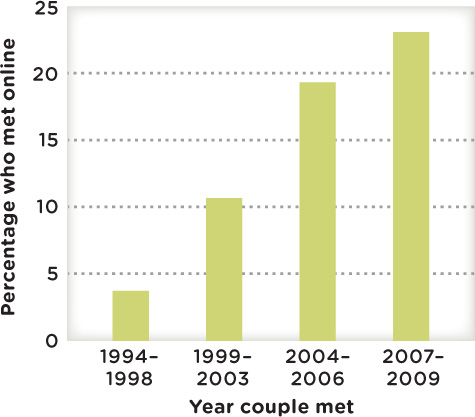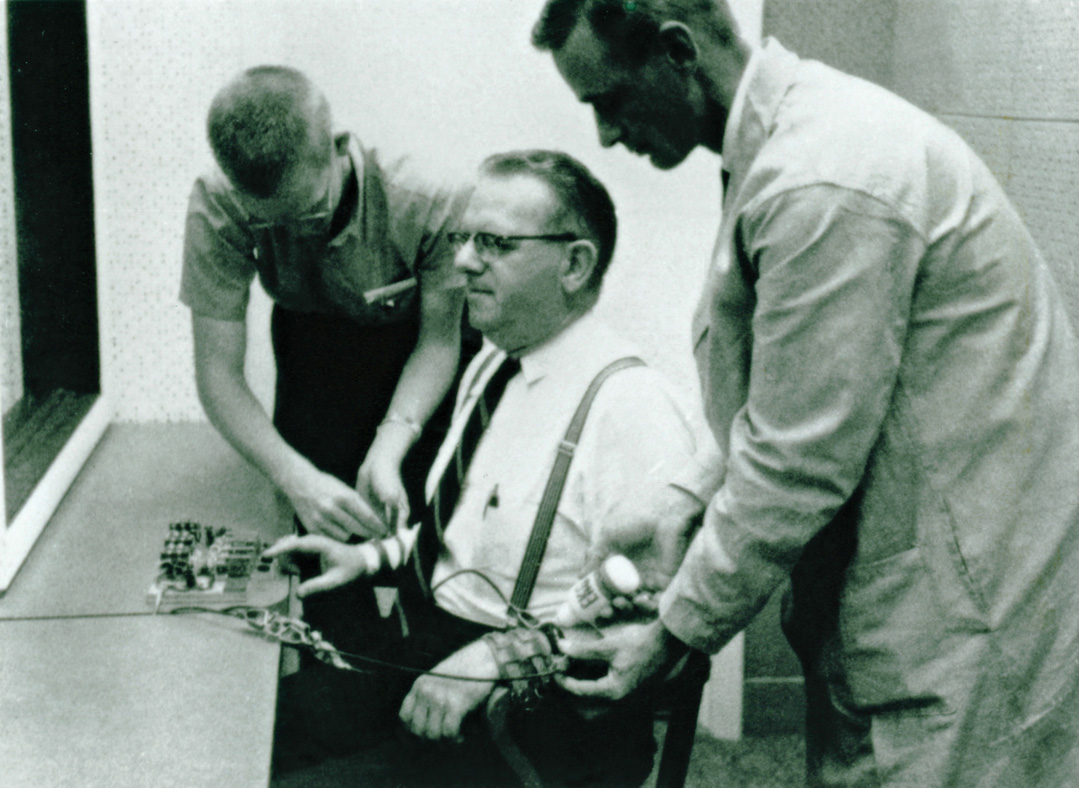15.1 An Introduction to Social Psychology
social psychology
LOVE STORY
An Introduction to Social Psychology
LOVE STORY
Prior to 2006, Joe Maggio did not have the best of luck with women. While serving overseas in the military, he had a relationship with a local woman with whom he was not at all compatible. But something beautiful came out of their failed union: a baby girl named Kristina. Joe was awarded full custody, and he returned to Long Island, New York, to begin his life as a single dad. In between work and taking care of his daughter, there was little time for dating. Joe was not the type to frequent bars and nightclubs, and his work as an ice cream truck driver provided few opportunities for meeting other singles. It never seemed to work out with the girlfriends he did manage to date. And as Joe admits, “I had my share of doozies [extraordinarily bad experiences].”
After several years of dating frustrations, everything abruptly changed. Susanne entered the picture. Their first face-to-face meeting was at a Chili’s restaurant. Joe and his daughter, then 7 years old, were chatting at a table when Susanne appeared. “The minute she walked in the door on our first date, I honestly felt like I was actually waiting for my wife to have dinner with me and my daughter,” Joe says. He remembers exactly how she looked: straight hair, a pink blouse with a butterfly necklace, a black vest, and a pair of blue jeans. As Joe puts it, “Very, very cute.”
Instantly at ease, Susanne sat down and began to talk with Joe and Kristina. “It was just kind of relaxed … like we had known each other forever,” says Susanne, who had encountered her own share of unique individuals before meeting Joe. At 32, she was finished playing games and exploring dead-end relationships. “At this point in my life I was really just looking for somebody that wanted to settle down,” she offers. Joe seemed so kind, it was hard to believe he was authentic.
After eating dinner and watching The Pink Panther at a nearby movie theater (“a child-catered kind of date,” as Joe calls it), Joe and Kristina bid Susanne farewell—but only for a matter of hours. The next morning, Joe called Susanne and invited her for a cup of coffee. “We did not leave the local Starbucks until almost seven, eight hours later,” he recalls. During that marathon date, Joe and Susanne shared stories about their families and talked about their hopes and dreams. “I didn’t want the day to end,” says Joe, who then invited Susanne home and made her a dinner of sautéed pork chops, roasted peppers, and potatoes. “I think I kind of won her heart that night.”

Joe and Susanne’s initial impressions of one another were right on. They were extremely compatible people with similar backgrounds and family values. Both were big fans of cooking, baseball (the Mets), and spending Friday night curled up on the couch watching a movie. Susanne found it attractive that Joe was a single father. And Joe came to love how Susanne treated Kristina like her own daughter, and how Kristina loved her back. You might say Joe and Susanne were perfectly matched. How did they find one another?
LEARNING OBJECTIVES
after reading and studying this chapter, you should be able to:
- LO 1 Define social psychology and identify how it is different from sociology.
- LO 2 Describe social cognition and how we use attributions to explain behavior.
- LO 3 Explain how attributions lead to mistakes about the causes of behaviors.
- LO 4 Describe social influence and recognize the factors associated with persuasion.
- LO 5 Define compliance and explain some of the techniques used to gain it.
- LO 6 Evaluate conformity and identify the factors that influence the likelihood of someone conforming.
- LO 7 Describe obedience and explain how Stanley Milgram studied it.
- LO 8 Recognize the circumstances that influence the occurrence of the bystander effect.
- LO 9 Demonstrate an understanding of aggression and identify some of its causes.
- LO 10 Recognize how group affiliation influences the development of stereotypes.
- LO 11 Compare prosocial behavior and altruism.
- LO 12 Identify the three major factors contributing to interpersonal attraction.
What Is Social Psychology?
Joe and Susanne did not meet at a church, a library, or a bar. They did not work in the same office, nor were they introduced by mutual friends. Like a growing number of couples, Joe and Susanne first encountered one another online. They met through a popular Internet dating Web site called Match.com.
Note: Quotations attributed to Julius Achon and Joe and Susanne Maggio are personal communications.
In less than two decades, online dating has gone from being essentially nonexistent to a primary avenue for finding love (Figure 15.1). Research suggests that the Internet is the second most common way to connect with a potential partner, the first being an introduction by mutual friends (Finkel, Eastwick, Karney, Reis, & Sprecher, 2012). Joe and Susanne met through one of the mainstream dating sites, but there are also highly specialized services to accommodate particular interests. Looking for a vegetarian mate? Try VeggieDate.org. Searching for a farmer to love? Visit FarmersOnly.com. There are even dating sites designed to match people with the same book preferences and food allergies.

Dating Web sites have forever changed the singles’ landscape. What other medium allows you to scan and research a database of thousands, if not millions, of potential partners from the comfort of your sofa? How else can you narrow your search to “Asian heterosexual male Democrat between the ages of 30 and 35 in the 85702 zip code who enjoys football” in a matter of seconds? Internet dating has also created a new laboratory for psychologists to study the way people’s thoughts, emotions, and behaviors are influenced by others. In other words, it is an emerging topic of research in social psychology.
LO 1 Define social psychology and identify how it is different from sociology.
In every chapter of this book, we have touched on issues relevant to social psychology. Chapter 1, for example, tells the story of 33 Chilean miners trapped in a sweltering, underground hole for more than 2 months. How do you think the social interactions among these men influenced their behaviors, thoughts, and feelings? In Chapter 3, we journeyed into the world of Zoe, Emma, and Sophie, identical deaf and blind triplets. How might the triplets’ social behaviors differ from those of children with normal hearing and vision? Then there was Clive Wearing from Chapter 6. How do you suppose Clive’s devastating memory loss affects his relationships? Social psychologists strive to answer these types of questions.
Social psychology is the study of human cognition, emotion, and behavior in relation to others. Throughout this text, we have emphasized the importance of the biopsychosocial perspective, which recognizes the biological, psychological, and social forces underlying human behavior. This chapter focuses on the third aspect of that triad: social forces.
What’s The Difference? Social Psychology Versus Sociology
Students often ask how social psychology differs from the field of sociology. The answer is simple: Social psychology explores the way individuals behave in relation to others and groups, while sociology examines the groups themselves—their cultures, societies, and subcultures. A social psychologist studying religion might focus on the relationship between congregants and their spiritual leaders. A sociologist would more likely investigate religious practices, rituals, and organizations. Perhaps the most obvious differences lie in the methods used to conduct research. Let’s take a look at how social psychologists design their experiments.
Research Methods in Social Psychology
CONNECTIONS
In Chapter 1, we described how participants’ and researchers’ expectations can influence the results of an experiment. One form of deception used to counter this is the double-blind study, in which neither participants nor researchers administering a treatment know who is getting the real treatment. Participants are told ahead of time they might receive a placebo.
Social psychologists use the same general research methods as other psychologists, but often with an added twist of deception. Deception is sometimes necessary because people do not always behave naturally when they know they are being observed. Some participants try to conform to expectations; others do just the opposite, behaving in ways they believe will contradict the researchers’ predictions. Suppose a team of researchers is studying facial expressions in social settings. If participants know that every glance and grimace are being analyzed, they may feel self-conscious and display atypical facial expressions. Instead of telling participants the real focus of the study, researchers might lead them to believe they are participating in a study on, say, problem solving. That way, they can study the behavior of interest (facial expressions in social settings) more naturally.

Social psychology studies often involve confederates, who are people secretly working for the researchers. Playing the role of participants, experimenters, or simply bystanders, confederates say what the researchers tell them to say and do what the researchers tell them to do. They are, unknown to the other participants, just part of the researchers’ experimental manipulation.
In most cases, the deception is not kept secret forever. Researchers debrief their participants at the end of a study or review aspects of the research initially kept under wraps. Even after learning about the deceit, many participants report they are willing to take part in subsequent psychology experiments (Blatchley & O’Brien, 2007). Debriefing is also a time when researchers make sure that participants were not harmed or upset by their involvement in a study. We should note that all psychology research affiliated with colleges and universities must be approved by an Institutional Review Board (IRB) to ensure that no harm will come from participation. This requirement is partly a reaction to early studies involving extreme deception and manipulation—studies that many viewed as dehumanizing and unethical. Psychologists agree that deception is only acceptable if there is no other way to study the topic of interest. We will describe many examples of such research in the upcoming pages, but first let’s familiarize ourselves with some of the basic concepts in social psychology.
CONNECTIONS
In Chapter 1, we discussed informed consent and debriefing. Debriefing is an ethical component of disclosure in which researchers provide participants with useful information related to the study. In some cases, participants are informed of deception or manipulation they were exposed to in the study, information that couldn’t be revealed to them beforehand.
show what you know
Question 15.1
1. __________ studies individuals in relation to others and groups, whereas __________ studies the groups themselves, including cultures and societies.
- Sociology; social psychology
- Social psychology; sociology
- Sociology; a confederate
- A confederate; social psychology
b. Social psychology; sociology
Question 15.2
2. When a participant has completed his involvement in a research project, generally the researcher will __________ him by discussing aspects of the study and making sure he was not upset or harmed by his involvement.
debrief
Question 15.3
3. Social psychology research occasionally involves some form of deception that includes a confederate. How is this type of deception different from the use of double-blind studies?
Social psychology studies often involve confederates, who are working for the researchers. Playing the role of participants, confederates say what the researchers tell them to say and do what the researchers tell them to do. They are, unknown to the other participants, just part of the researchers’ experimental manipulation. In a double-blind study, neither participants nor researchers administering a treatment know who is getting the real treatment. Participants are told ahead of time that they might receive a placebo, but do not necessarily know about confederates until after the study is complete.